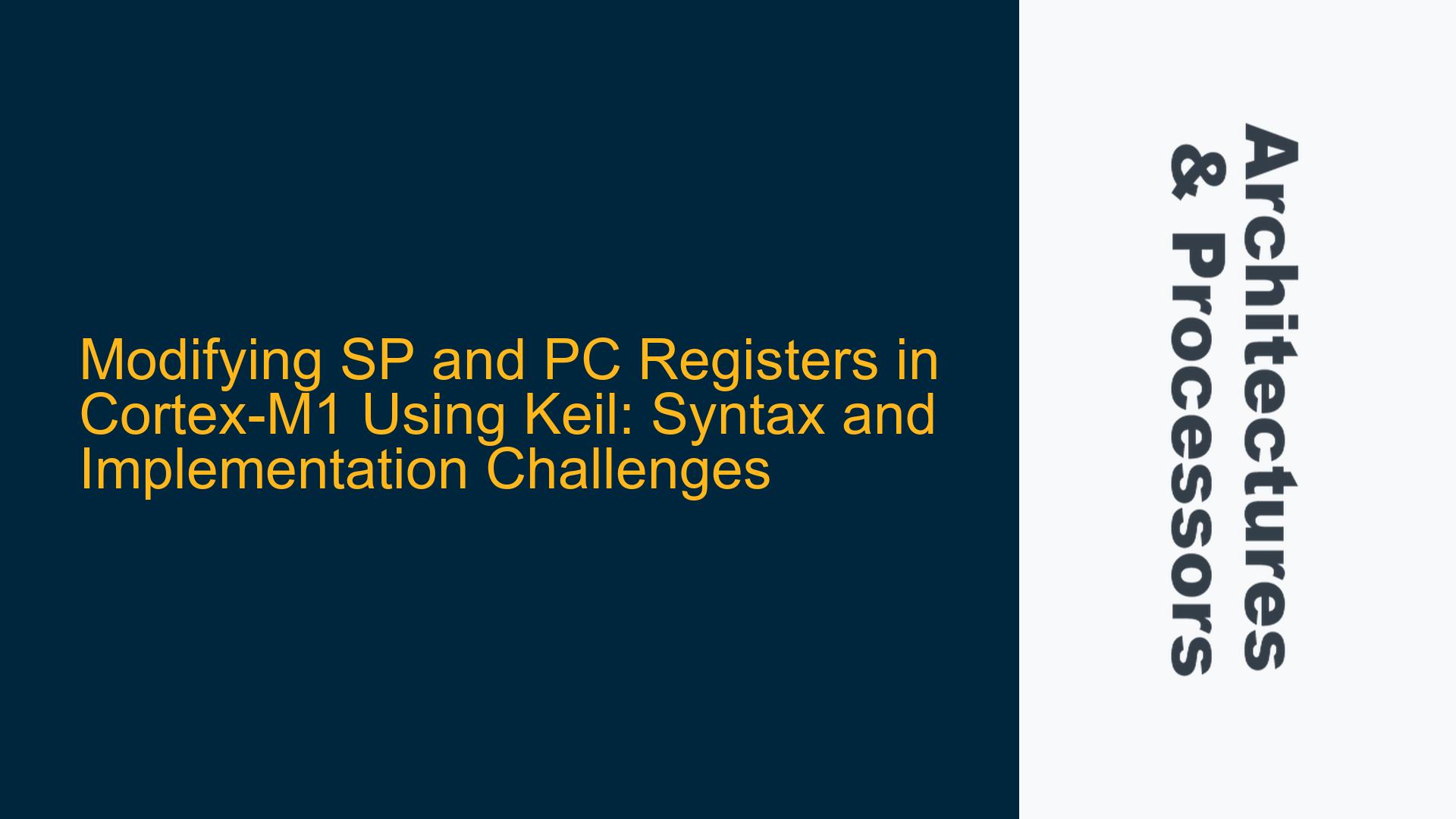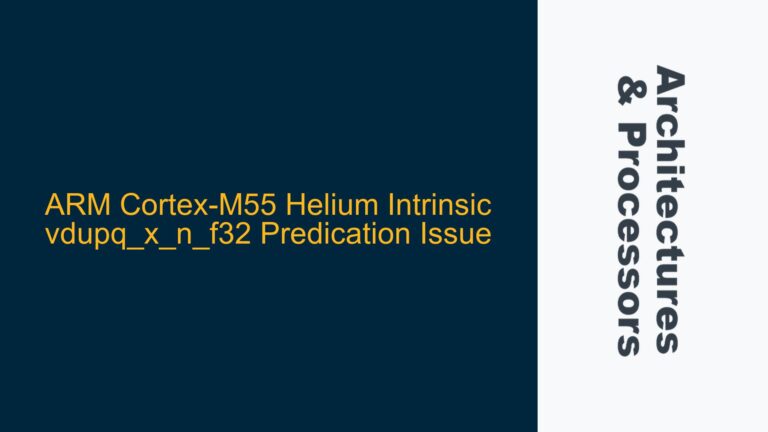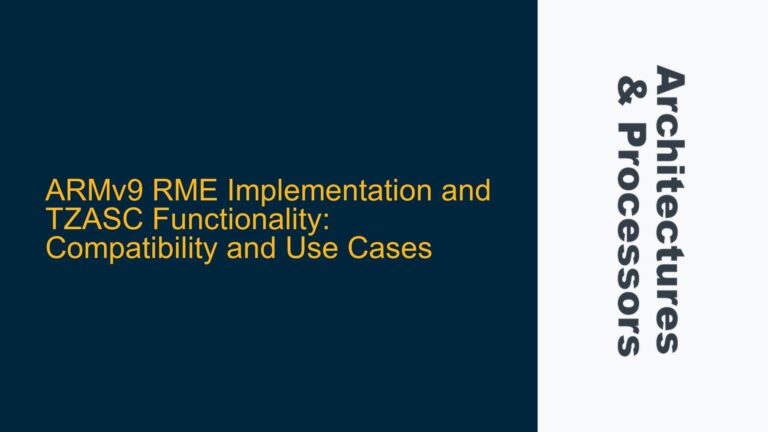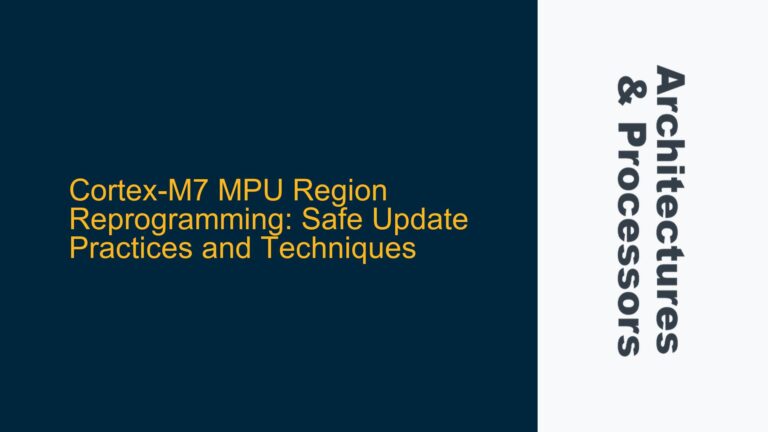ARM Cortex-M1 SP and PC Register Modification Errors in Keil
When working with the ARM Cortex-M1 processor, modifying the Stack Pointer (SP) and Program Counter (PC) registers is a critical task, especially when developing a bootloader. However, developers often encounter challenges when attempting to modify these registers using inline assembly in the Keil development environment. The primary issue arises from the mismatch between the syntax used in the inline assembly code and the syntax expected by the ARM Compiler (ARMCC) in Keil. This mismatch can lead to compilation errors, such as the compiler expecting a closing parenthesis where it is not syntactically correct.
The ARM Cortex-M1 processor, being a member of the ARMv6-M architecture, has specific requirements for modifying the SP and PC registers. These registers are central to the processor’s operation, with the SP managing the stack and the PC controlling the flow of execution. Direct modification of these registers is often necessary during low-level programming tasks, such as bootloader development, where the initial stack setup and jump to the application code are required.
The Keil development environment, which uses the ARM Compiler (ARMCC), has a different syntax for inline assembly compared to the GNU Compiler Collection (GCC). This difference can lead to confusion and errors when developers attempt to use GCC-style inline assembly in Keil. Specifically, the ARMCC compiler expects a different syntax for inline assembly, and failing to adhere to this syntax can result in compilation errors.
GNU vs. ARMCC Syntax Mismatch and Register Access Restrictions
The core issue stems from the syntax mismatch between GNU inline assembly and ARMCC inline assembly. In GNU-style inline assembly, the syntax is more flexible and allows for direct manipulation of registers, including the SP and PC. However, ARMCC has a more restrictive syntax and does not allow direct modification of the SP and PC registers using inline assembly. This restriction is in place to prevent potential issues that could arise from improper manipulation of these critical registers.
In the provided example, the developer attempted to use GNU-style inline assembly to modify the SP and PC registers:
__asm__ __volatile__("mov sp,%0\n\t"
"bx %1\n\t"
: /* no output */
: "r"(sp), "r"(pc)
: "sp");
This code snippet uses the __asm__ __volatile__ keyword, which is typical for GNU-style inline assembly. The mov instruction is used to load the SP register with the value of the sp variable, and the bx instruction is used to branch to the address stored in the pc variable. The : "r"(sp), "r"(pc) part specifies that the sp and pc variables are to be loaded into general-purpose registers before the assembly code is executed. The : "sp" part is a clobber list, indicating that the SP register is modified by the assembly code.
However, this syntax is not compatible with ARMCC. The ARMCC compiler expects a different syntax for inline assembly, and it does not support the direct modification of the SP and PC registers using inline assembly. This incompatibility leads to compilation errors, such as the compiler expecting a closing parenthesis where it is not syntactically correct.
Furthermore, the ARM Cortex-M1 architecture imposes restrictions on the modification of the SP and PC registers. These registers are critical to the processor’s operation, and improper modification can lead to undefined behavior or system crashes. As a result, the ARMCC compiler enforces these restrictions by disallowing direct modification of the SP and PC registers using inline assembly.
Implementing SP and PC Modifications via Separate Assembly Files
Given the restrictions on modifying the SP and PC registers using inline assembly in ARMCC, the recommended approach is to use separate assembly files for these operations. This approach allows for direct manipulation of the SP and PC registers without running into the syntax and access restrictions imposed by the ARMCC compiler.
To implement this, you can create a separate assembly file (e.g., bootloader.s) and write the necessary assembly code to modify the SP and PC registers. The following example demonstrates how to modify the SP and PC registers in a separate assembly file:
AREA |.text|, CODE, READONLY
EXPORT SetRegisters
SetRegisters
; Load the SP register with the value passed in R0
MOV SP, R0
; Branch to the address passed in R1
BX R1
END
In this assembly code, the SetRegisters function is defined, which takes two arguments: the new value for the SP register (passed in R0) and the new value for the PC register (passed in R1). The MOV SP, R0 instruction loads the SP register with the value in R0, and the BX R1 instruction branches to the address stored in R1.
To call this function from your C code, you can declare the function prototype and call it with the appropriate arguments:
extern void SetRegisters(unsigned int sp, unsigned int pc);
void BootloaderEntry(void) {
unsigned int new_sp = 0x20001000; // Example stack pointer value
unsigned int new_pc = 0x08000000; // Example program counter value
SetRegisters(new_sp, new_pc);
}
In this C code, the SetRegisters function is declared as an external function, and it is called with the desired values for the SP and PC registers. This approach allows you to modify the SP and PC registers without running into the limitations of inline assembly in ARMCC.
Detailed Explanation of the Assembly Code
The assembly code provided above is written in ARM assembly language and is designed to be compatible with the ARM Cortex-M1 processor. Let’s break down the code in detail:
-
AREA Directive: The
AREAdirective is used to define a section of memory. In this case, the.textsection is defined as a CODE section with READONLY attributes. This section will contain the executable code for theSetRegistersfunction. -
EXPORT Directive: The
EXPORTdirective is used to make theSetRegistersfunction visible to other modules. This allows the function to be called from C code. -
SetRegisters Function: The
SetRegistersfunction is defined as a label. This function takes two arguments: the new value for the SP register (passed inR0) and the new value for the PC register (passed inR1). -
MOV SP, R0: The
MOVinstruction is used to load the SP register with the value inR0. This sets the stack pointer to the new value provided by the caller. -
BX R1: The
BXinstruction is used to branch to the address stored inR1. This sets the program counter to the new value provided by the caller, effectively jumping to the new code location. -
END Directive: The
ENDdirective marks the end of the assembly file.
Detailed Explanation of the C Code
The C code provided above is used to call the SetRegisters function from a C environment. Let’s break down the code in detail:
-
Function Prototype: The
extern void SetRegisters(unsigned int sp, unsigned int pc);line declares theSetRegistersfunction as an external function. This tells the compiler that the function is defined elsewhere (in the assembly file) and can be called from C code. -
BootloaderEntry Function: The
BootloaderEntryfunction is defined as an example entry point for the bootloader. This function sets up the new values for the SP and PC registers and calls theSetRegistersfunction to apply these values. -
new_sp and new_pc Variables: The
new_spandnew_pcvariables are defined to hold the new values for the SP and PC registers. In this example, the stack pointer is set to0x20001000, and the program counter is set to0x08000000. These values are just examples and should be replaced with the actual values required by your application. -
SetRegisters Function Call: The
SetRegisters(new_sp, new_pc);line calls theSetRegistersfunction with the new values for the SP and PC registers. This triggers the assembly code to modify the registers accordingly.
Considerations for Bootloader Development
When developing a bootloader for the ARM Cortex-M1 processor, there are several considerations to keep in mind:
-
Stack Initialization: The stack pointer must be initialized to a valid memory region before any function calls or local variables are used. The stack is used for storing return addresses, local variables, and function parameters, so it is critical to ensure that the stack is properly set up.
-
Jump to Application Code: The program counter must be set to the entry point of the application code. This is typically done by branching to the address of the application’s reset handler or main function.
-
Memory Layout: The memory layout of the bootloader and application code must be carefully planned to avoid conflicts. This includes defining the memory regions for code, data, stack, and heap.
-
Interrupt Handling: If the bootloader needs to handle interrupts, the interrupt vector table must be properly set up. This includes defining the exception handlers and ensuring that the stack is properly initialized before any interrupts occur.
-
Security Considerations: In some cases, the bootloader may need to implement security features, such as verifying the integrity of the application code before jumping to it. This can be done using cryptographic checksums or digital signatures.
Conclusion
Modifying the SP and PC registers in the ARM Cortex-M1 processor using Keil requires careful attention to the syntax and restrictions imposed by the ARMCC compiler. The use of separate assembly files is the recommended approach for modifying these critical registers, as it avoids the limitations of inline assembly and ensures proper operation of the processor. By following the guidelines and examples provided in this guide, developers can successfully implement bootloader functionality and other low-level tasks that require direct manipulation of the SP and PC registers.






